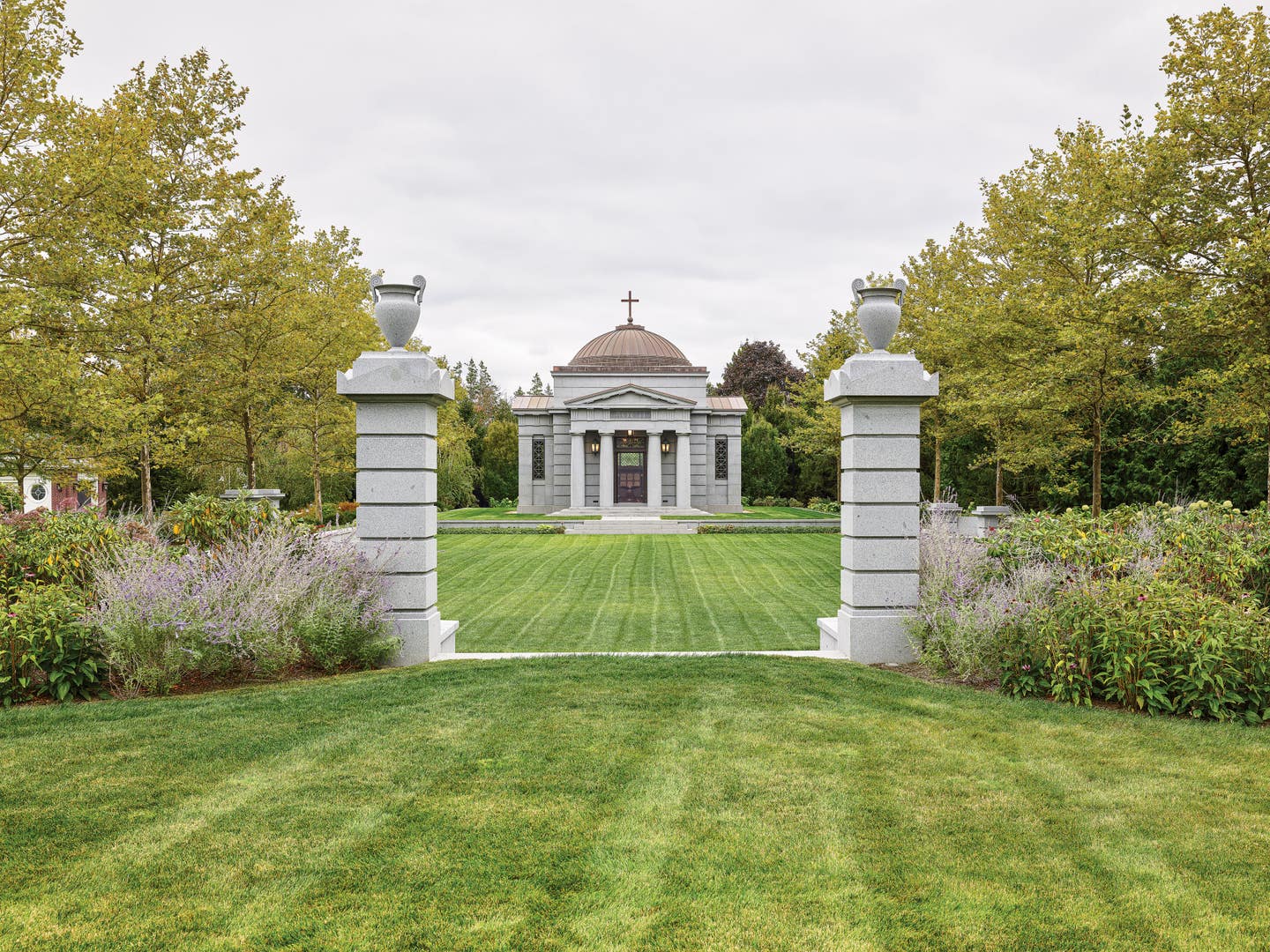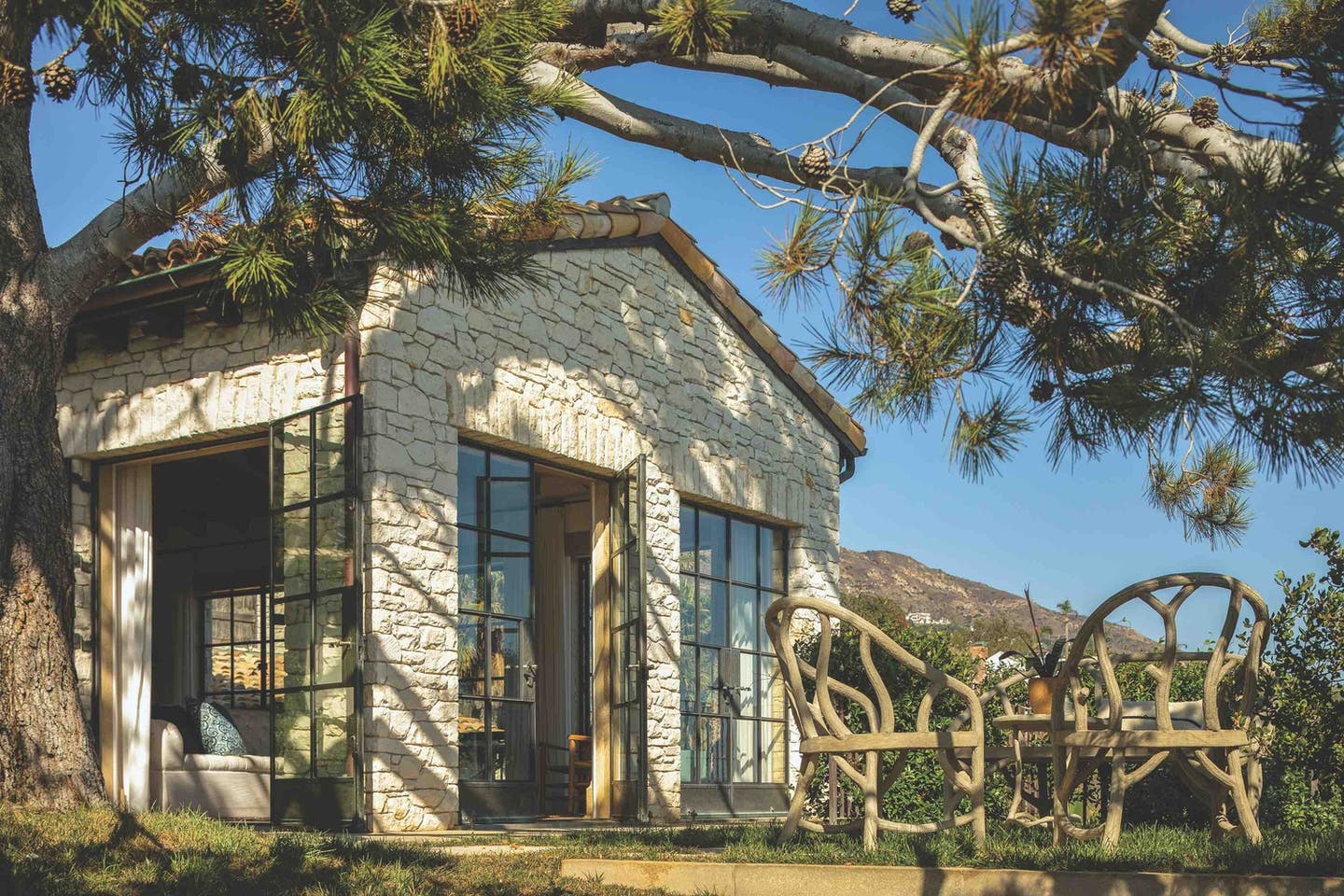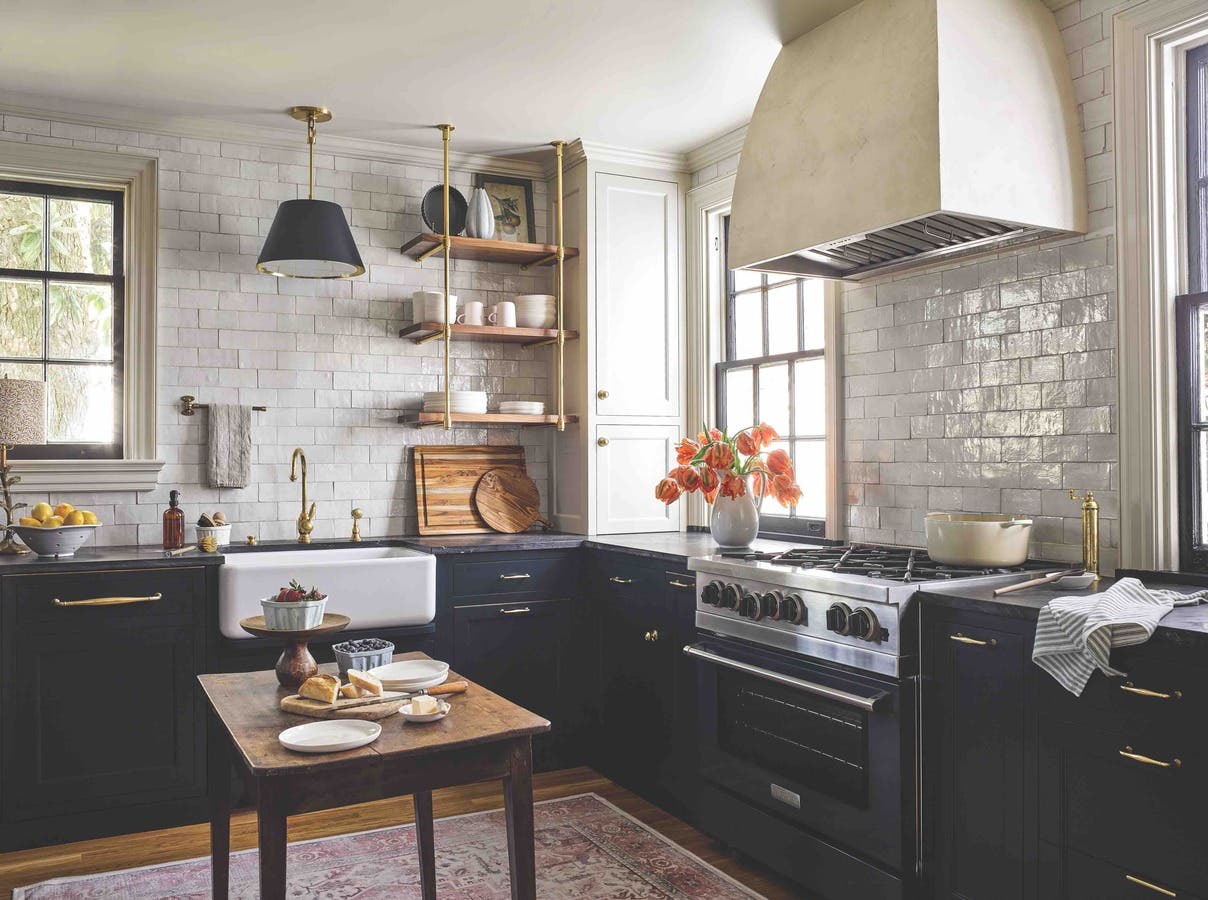
Projects
Eric Inman Daum Architect Creates a Private Mausoleum
Architect Eric Daum is modest about his work on this private mausoleum in Norwood, Massachusetts, preferring instead to speak of his sources of inspiration. Completed in 2018, the Neo-classical structure emphasizes the austerity of the Greek Revival period but its references are many. “There are a number of formal precedents for the overall design concept of the pavilion,” explains the principal of Eric Inman Daum Architect, noting that the Doric order is based on the Parthenon, and the lower-level crypt recalls the Temple of Hera. “One of the most prominent,” he adds, “was the Württemberg Mausoleum outside Stuttgart, Germany, which was designed in 1819 by Italian architect Giovanni Salucci.” There are also a few less formal precedents, including the Custom House in Boston and the First Parish Church in Quincy.
For context, Daum notes his long-term association with the property and client. He has contributed to the site’s architecture for more than a decade. Most of that work was “in a Georgian direction”—meaning a lot of red brick with white trim. Eventually, a Greek Revival–style guesthouse was added, opposite which the new pavilion now sits. “Since we had already broken a stylistic reference with the guesthouse,” Daum says, “I felt that it was okay to do another Greek Revival–influenced building. I wanted something that felt a little more somber, a little less celebratory—something with a massive, earthy presence.”
That somber quality comes through, and is owed, in part, to the order’s robust proportions and to the masonry itself, which Daum chose for its similarity to Quincy granite. He points to the historic use of that stone for New England’s civic buildings, appreciating its dark, dense, and finely grained nature. However, because Quincy granite is no longer quarried, Daum had to find a proximate match. A recommendation from stone expert Kenneth Castellucci led him to the Coldspring granite on which he ultimately settled.
Originally conceived to be an unconditioned single-story mausoleum, the pavilion’s design evolved to include a lower-level crypt. And because the client expressed interest in using the building on a year-round basis, Daum needed to design for HVAC systems and plumbing. “In order to accommodate those things, we had to increase the overall size of the building while keeping the same look,” the architect explains. “So everything had to be scaled up. It was a design of response. It was a concept that got developed and then reimagined, and then further redeveloped.”
Along the way, the crypt became a series of belowground tombs designed to have granite covers, which were indeed fabricated but are currently in storage. The client wanted to be able to use the lower level as a casino-like space, hence the posh Venetian fabrics and richly upholstered tombs. (These added flourishes were not of Daum’s design.) “My approach to the crypt was for it to have the weight of what was happening above, as well as make a temporal shift backward in time,” he explains. “So the forms of the Doric order used below are more abstracted and primitive. They reference the ruins of the Temple of Hera in Sicily—the idea being that it is an earlier iteration, and the building above was built to be more modern.”
In addition to changing priorities, Daum was contending with residential building code restrictions. “It was a balancing act between getting the appropriate proportioning of the orders and getting the appropriate proportioning of the site, as well as getting the dome’s height right while dealing with the code height limitations,” he says, indicating the many challenges that were surmounted.
A Closer Look at the Architecture
According to Daum, this 2019 Bulfinch Award-winning project is a contemporary classical design reflecting many aspects of the Neo-classical movement of the late 18th and 19th centuries. Winning in the ecclesiastic category, the structure references Robert Adam’s Bowood Mausoleum in Wiltshire, England—a dome suspended above a square plan on flat pendentives. With freestanding columns supporting a pediment, the north façade is a true temple front. The east and west façades do not project as far, and they have square piers, wall extrusions, and bronze windows between them—the grilles of which are a Roman motif from antiquity. Despite the plan being Greek Revival–inspired, Daum notes that the domed central block would not have been seen in Greek architecture, the dome having been introduced to the Classical tradition by the Romans.
Though the main volume of the Württemberg Chapel—again, a primary reference—is circular in plan, it is unique for its four projecting porches, the cornices of which continue around the entire building, thereby creating a vertical surface for the pediments to terminate against, which is what Daum did here. On the Greek Doric order, he bestowed a squat, muscular appearance. And, in the vein of the Temple of Nemesis at Rhamnus, the unfluted column shafts—turned from a single block of granite—include a thin groove around the circumference (called necking), which separates the shaft from the capital. The remnant above the necking is distinctly fluted beneath the echinus of the capital.
The dome and roofs of the four wings are covered in standing-seam copper sheeting; the remaining portions at the corners feature flat-seam copper. Entry is through bronze doors set in a granite surround. The vestibule door jambs are notable for the way they slope inward—a common Grecian motif, Daum explains, that recalls the Bronze Age Treasury of Atreus, also named Tomb of Agamemnon.
Inside, the sanctuary is square in plan with a pier in each corner, and the Greek Doric order continues. Six columns, carved from dark green Verde Alpi marble, are fluted for their entire length; their high polish and deep veining add drama to the space. Twenty-four bays feature in the coffered dome—symbolizing the hours of the day—each of which is framed by egg-and-dart moldings, as are the coffered ceilings of the three wings. At the apex of the dome is a stained-glass daylight in a compass pattern meant to symbolize the setting sun. Disrupting the somber granite, the polychromed marble radial mosaic floor—cut and carved in Italy—was inspired by a floor in Karl Friedrich Schinkel’s Glienecke Casino. The use of a Greek Key in Nero Marquina and Giallo Siena marble was meant to tie the floor to the austere Greek Revival scheme.
Below the sanctuary is the crypt. Daum explains that the four central columns are in the early Doric style found in the former Greek colonies in Sicily at Paestum. They were given a squatter proportion than those on the upper story to suggest the weight of mourning.
A Bit About the Gardens
The domed temple sits at the end of a sunken lawn in the southwest corner of the residential estate. “The lawn is meant to be a place of contemplation,” says Brian Frazier, whose firm, Brian Frazier Design, was responsible for the landscape and gardens surrounding the pavilion (and beyond—he, too, has been working on the property for many years).
To visually tie together the garden piers, walks, and paving to the building, Frazier used the same granite. For structure, and to draw the eye toward the pavilion, he designed an allée of London plane trees, which were chosen for the bark’s texture and because they can withstand the heavy pruning that will be necessary to keep them in scale and away from the building. Hydrangea, Russian sage, and “Knockout” series roses create the understory. Behind the pavilion, Frazier planted a hedgerow of columnar Hornbeam trees, which he specified for their brilliant fall color.
A beguiling pebble terrace sits directly on axis, and is made of black and white Mexican beach stones that were handpicked for size. On the whole, the property’s landscape is linear in design—meant to guide visitors with clear site lines. The pebbled terrace provides relief with its curvilinear, freeform shape. Each stone was laid by hand to create a series of curves that reverse in on each other, and “garden rooms” hedged in eight-foot-tall yews surround the stonework. “Given the position of the garden pavilion, and the other buildings on the site—the main house and two carriage houses—and the way they relate to each other, I didn’t want to just do a series of lawns,” Frazier says of his intent. “I wanted to create some mystery to draw people through the landscape to make discoveries. That was the point of the garden rooms surrounding the pebble terrace.”
Inspired by a terrace at Dumbarton Oaks, it is arguably the landscape’s pièce de résistance. Regarding it, Frazier adds: “I tried to add some texture that would be unlike anything people had ever seen. In general, I’m trying to add things that are out of the ordinary because it is not an ordinary place and not an ordinary client. So I decorated the ground in a tapestry, like a rug in a room.”
Taken together, the domed pavilion and formal gardens could be said to symbolize the circle of life and death—made all the more beautiful by the myriad references to antiquity.
Plaster Dome
The dome created by Foster Reeve from Eric Daum’s precise drawing represented a multifaceted challenge the team. Geometry, engineering, coordination, and, of course, a little sculpture. Beginning with site measurements, the team maximized the size of the dome for its relationship to the oculus above and to the as built concrete square at the bottom. From there they scaled the design to most closely match the architect’s intent. Selection of the ornament involved architect review of samples from our ornament library to choose the style from which to sculpt the precisely scaled elements. The egg and dart was carefully modulated to create perfect corners on the various panel sides. The installation of precast ceilings goes surprisingly quickly, if all the planning and shop work are properly executed. There is no framing to be built beforehand, and all coordination with adjacent or embedded elements is carefully mapped out in the shop drawings. Blocking and bracing are provided as needed during the installation, with location and design of the seams planned for ease of finishing. Delivering a finished product of this complexity, and having it quickly transform a raw interior into a finished space was especially rewarding to the team.
Key Suppliers
Architecture Eric Inman Daum Architect and former partner of Merrimack Design Architects
Builder KVC Builders
Landscape designer Brian Frazier Design
Landscape construction R.P. Marzilli & Company
Interior design Anthony Catalfano Interiors
Millwork South Shore Millwork
Plaster Foster Reeve
Natural stone work Kenneth Castellucci & Associates, Inc.
Granite Cold Spring Granite
Bronze Wiemann Metalcraft
Bronze doors & windows Tischler Und Sohn
Hardware Maison Vervloet
Wood finishing Wayne Towle Master Finishing and Restoration
Tech integration Maverick Integration








